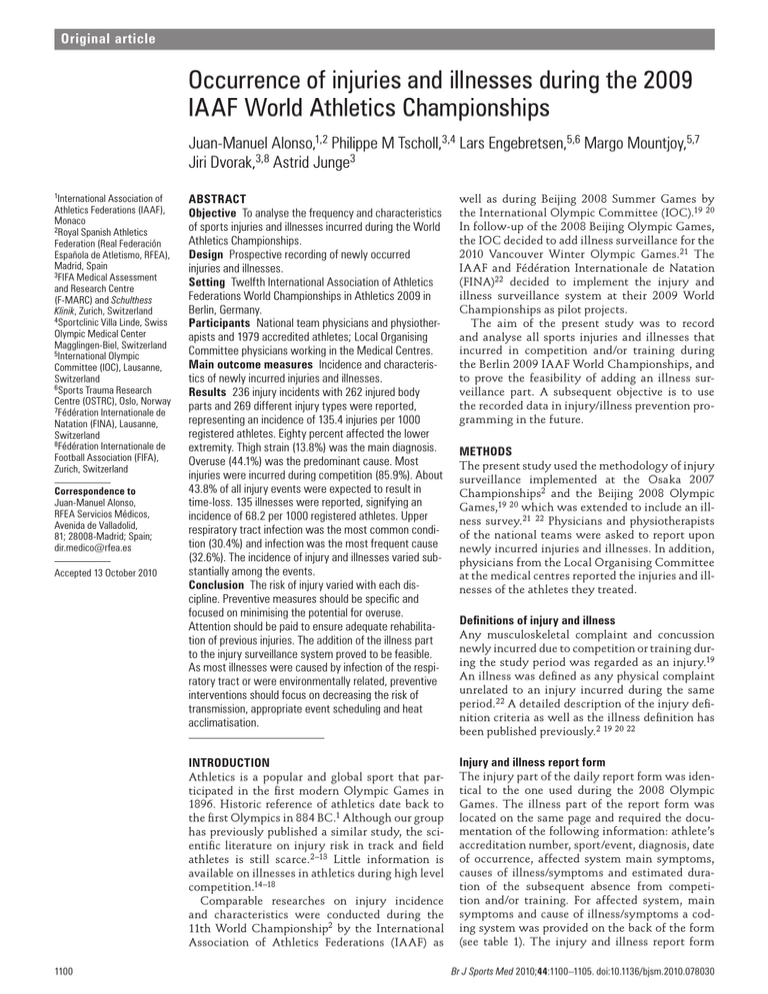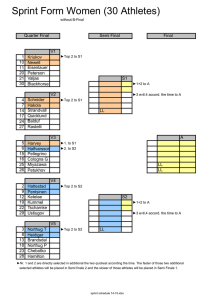
Original article
Occurrence of injuries and illnesses during the 2009
IAAF World Athletics Championships
Juan-Manuel Alonso,1,2 Philippe M Tscholl,3,4 Lars Engebretsen,5,6 Margo Mountjoy,5,7
Jiri Dvorak,3,8 Astrid Junge3
1International Association of
Athletics Federations (IAAF),
Monaco
2Royal Spanish Athletics
Federation (Real Federación
Española de Atletismo, RFEA),
Madrid, Spain
3FIFA Medical Assessment
and Research Centre
(F-MARC) and Schulthess
Klinik, Zurich, Switzerland
4 Sportclinic Villa Linde, Swiss
Olympic Medical Center
Magglingen-Biel, Switzerland
5International Olympic
Committee (IOC), Lausanne,
Switzerland
6 Sports Trauma Research
Centre (OSTRC), Oslo, Norway
7Fédération Internationale de
Natation (FINA), Lausanne,
Switzerland
8Fédération Internationale de
Football Association (FIFA),
Zurich, Switzerland
Correspondence to
Juan-Manuel Alonso,
RFEA Servicios Médicos,
Avenida de Valladolid,
81; 28008-Madrid; Spain;
dir.medico@rfea.es
Accepted 13 October 2010
1100
ABSTRACT
Objective To analyse the frequency and characteristics
of sports injuries and illnesses incurred during the World
Athletics Championships.
Design Prospective recording of newly occurred
injuries and illnesses.
Setting Twelfth International Association of Athletics
Federations World Championships in Athletics 2009 in
Berlin, Germany.
Participants National team physicians and physiotherapists and 1979 accredited athletes; Local Organising
Committee physicians working in the Medical Centres.
Main outcome measures Incidence and characteristics of newly incurred injuries and illnesses.
Results 236 injury incidents with 262 injured body
parts and 269 different injury types were reported,
representing an incidence of 135.4 injuries per 1000
registered athletes. Eighty percent affected the lower
extremity. Thigh strain (13.8%) was the main diagnosis.
Overuse (44.1%) was the predominant cause. Most
injuries were incurred during competition (85.9%). About
43.8% of all injury events were expected to result in
time-loss. 135 illnesses were reported, signifying an
incidence of 68.2 per 1000 registered athletes. Upper
respiratory tract infection was the most common condition (30.4%) and infection was the most frequent cause
(32.6%). The incidence of injury and illnesses varied substantially among the events.
Conclusion The risk of injury varied with each discipline. Preventive measures should be specific and
focused on minimising the potential for overuse.
Attention should be paid to ensure adequate rehabilitation of previous injuries. The addition of the illness part
to the injury surveillance system proved to be feasible.
As most illnesses were caused by infection of the respiratory tract or were environmentally related, preventive
interventions should focus on decreasing the risk of
transmission, appropriate event scheduling and heat
acclimatisation.
well as during Beijing 2008 Summer Games by
the International Olympic Committee (IOC).19 20
In follow-up of the 2008 Beijing Olympic Games,
the IOC decided to add illness surveillance for the
2010 Vancouver Winter Olympic Games.21 The
IAAF and Fédération Internationale de Natation
(FINA)22 decided to implement the injury and
illness surveillance system at their 2009 World
Championships as pilot projects.
The aim of the present study was to record
and analyse all sports injuries and illnesses that
incurred in competition and/or training during
the Berlin 2009 IAAF World Championships, and
to prove the feasibility of adding an illness surveillance part. A subsequent objective is to use
the recorded data in injury/illness prevention programming in the future.
METHODS
The present study used the methodology of injury
surveillance implemented at the Osaka 2007
Championships2 and the Beijing 2008 Olympic
Games,19 20 which was extended to include an illness survey. 21 22 Physicians and physiotherapists
of the national teams were asked to report upon
newly incurred injuries and illnesses. In addition,
physicians from the Local Organising Committee
at the medical centres reported the injuries and illnesses of the athletes they treated.
Definitions of injury and illness
Any musculoskeletal complaint and concussion
newly incurred due to competition or training during the study period was regarded as an injury.19
An illness was defi ned as any physical complaint
unrelated to an injury incurred during the same
period. 22 A detailed description of the injury definition criteria as well as the illness defi nition has
been published previously.2 19 20 22
INTRODUCTION
Injury and illness report form
Athletics is a popular and global sport that participated in the fi rst modern Olympic Games in
1896. Historic reference of athletics date back to
the fi rst Olympics in 884 BC.1 Although our group
has previously published a similar study, the scientific literature on injury risk in track and field
athletes is still scarce. 2 –13 Little information is
available on illnesses in athletics during high level
competition.14 –18
Comparable researches on injury incidence
and characteristics were conducted during the
11th World Championship2 by the International
Association of Athletics Federations (IAAF) as
The injury part of the daily report form was identical to the one used during the 2008 Olympic
Games. The illness part of the report form was
located on the same page and required the documentation of the following information: athlete’s
accreditation number, sport/event, diagnosis, date
of occurrence, affected system main symptoms,
causes of illness/symptoms and estimated duration of the subsequent absence from competition and/or training. For affected system, main
symptoms and cause of illness/symptoms a coding system was provided on the back of the form
(see table 1). The injury and illness report form
Br J Sports Med 2010;44:1100–1105. doi:10.1136/bjsm.2010.078030
Original article
was available in seven languages (English, French, Spanish,
German, Russian Arabic and Chinese). These report forms
were supplied to every national medical team with additional
information in a booklet.
teams was similar to the number reported by the LOC medical centres (131/137 for injuries and 73/76 for illnesses, respectively). Thirty-two injuries and 16 illnesses were reported
from both sources.
Data analysis
Frequency and characteristics of injury
The following parameters were analysed for risk evaluation
of the athletes:
▶ Gender
▶ Age (≤20 years of age, 21–25, 26–30, ≥31 years of age)
▶ Severity (time loss, no-time loss)
▶ Circumstance (training, competition)
▶ Type of event (Sprints: 100 m, 200 m, 400 m, 4 × 100 m,
4 × 400 m; Middle distances: 800 m, 1500 m; Long distances:
3000 m steeple, 5000 m, 10 000 m, marathon; Race walking: 20 km, 50 km; Hurdles: 100/110 m, 400 m; Jumps: high,
long, triple, pole vault; Throws: shot put, javelin, hammer,
discus; Combined events: decathlon, heptathlon).
All data were processed using Excel. Response rate, coverage
and incidences were calculated in accordance with the IOC
approach for injury surveillance,19 and previous studies during large international competitions. 2 20 22 Statistical methods
applied were means, frequencies with SD, cross-tabulations,
t test and χ2 test. Significance was accepted at p≤0.05.
A total of 236 injury incidents with 262 injured body parts
(six cases missing location) and 268 injury types (two cases
missing injury type) were reported, with a total incidence of
135.4±16.2 injuries per 1000 registered athletes. Almost 80%
of the injuries affected the lower extremity. The thigh (25.6%)
and the lower leg (21.0%) were most frequently injured, followed by the knee (9.5%). The trunk accounted for 13.0% of
all injuries. The most frequent types of injury were strains
(20.1%) and muscle cramps (21.6%), followed by skin lacerations (18.3%), tendinosis (10.8%) and sprain (6.3%). The most
common diagnosis was thigh strain (n=37; 13.8%), followed
by lower leg laceration (n=23, 8.6%) and muscle cramps of the
thigh and lower leg (n=22, 8.2% and n=17, 6.3%). For details
on affected body part and injury diagnoses see table 2.
Confidentiality and ethical approval
The athletes’ accreditation number was used only to avoid
duplicate reporting from team and LOC physicians and to provide information on age, gender and national federation of the
athlete from the IAAF database. All injury and illness reports
were stored in a locked fi ling cabinet and were made anonymous after the Championships. Confidentiality of all information was ensured so that no individual athlete or team could
be identified. Ethical approval was obtained from the Oslo
University School of Medicine Ethical Committee.
RESULTS
Response rate and coverage of athletes
In addition to the LOC medical centres, 47 medical teams out
of 200 national federations covering 1486 of 1979 registered
athletes (75.1%) participated in the data collecting process.
A total of 382 injury and illness report forms were returned.
Most of the countries participating in the study, including all
countries with more than 20 registered athletes, returned all
9 injury report forms, resulting in a response rate of 90.3%.
The number of injuries and illnesses reported by the national
Table 1
Circumstance, causes and severity of injury
Most injuries occurred during competition (n=220; 85.9%),
while only 36 occurred during training. This information was
missing for 12 injuries. Injuries during training and in competition were similar regarding location, type of injury and proportion of time-loss injuries, but significant differences were
observed for the cause of injury (χ2 =66.1; p=0.001), especially
for contact (2.0±2.0 vs 18.7±6.0 injuries per 1000 registered
athletes) and overuse injuries (8.6±4.1 vs 41.4±9.0).
Overuse injuries were dominant (44.1%), either with gradual (15.3%) or sudden onset (28.8%), followed by non-contact
trauma (12.7%) and contact with another athlete (11.9%).
Recurrence of previous injury (10.6%) and contact with a fi xed
object (5.5%) were more frequent than playing field conditions (2.1%), equipment failure and weather conditions (each
0.8%). For four injuries, more than one cause was stated. In
8.5% of the cases, the cause of injury was classified as ‘other’
or not specified.
The most frequent localisation for recurrent injuries was the
thigh (n=10) followed by the knee and ankle (three each). Ten
recurrent injuries were strains and five were diagnosed as tendinopathies. Half of them required rest from sporting activities; six athletes for up to 4 weeks, and four athletes for more
than 1 month.
Information in relation to time-loss from sport after injury
was available for 210 out of 236 injury incidents (89.0%).
Categories for the coding of illnesses
Code
Affected system
Main symptom(s)
Cause of illness/symptom(s)
1
2
3
4
5
6
7
8
9
10
11
12
Respiratory/ear, nose, throat
Gastro-intestinal
Uro-genital/gynaecological
Cardio-vascular
Allergic/immunological
Metabolic/endocrinological
Haematological
Neurological/psychiatric
dermatologic
Musculo-skeletal
Dental
Other
Fever
Pain
Diarrhoea, vomiting
Dyspnoea, cough
Palpitations
Hyper-thermia
Hypo-thermia
Dehydration
Syncope, collapse
Anaphylaxis
Lethargy, dizziness
Other
Pre-existing (eg, asthma, allergy)
Infection
Exercise-induced
Environmental
Reaction to medication
Other
Br J Sports Med 2010;44:1100–1105. doi:10.1136/bjsm.2010.078030
1101
Original article
Table 2 Number (%) and diagnosis of all injuries and injuries that
were expected to result in time-loss from sport in male and female
athletes
Number of all injuries (%)*
Number of time-loss
injuries†
Location and diagnosis
Men
Women
Men
Women
Head/neck
Concussion
Laceration
Muscle cramps
Other
Trunk
Sprain
Strain
Other bone injury
Dislocation
Contusion
Laceration
Tendinosis
Muscle cramps
Other
Upper extremity
Fracture
Sprain
Strain
Contusion
Tendinosis
Arthritis
Laceration
Hip
Strain
Contusion
Tendinosis
Laceration
Groin
Strain
Tendinosis
Thigh
Strain
Contusion
Tendinosis
Laceration
Muscle cramps
Others
Knee
Sprain
Lesion of cartilage/
meniscus
Contusion
Tendinosis
Laceration
Others
Lower leg
Stress fracture
Strain
Contusion
Tendinosis
Fasciitis
Laceration
Muscle cramps
Tendon rupture
Others
Achilles tendon
Tendinosis
Tendon rupture
Other
Ankle
Sprain/ligament
rupture
Laceration
Tendinosis
Contusion
Foot
Stress fracture
Other bone injury
Plantar fasciitis
Contusion
Arthritis
Laceration
Others
1 (0.6%)
0
1
0
0
21 (13.5%)
1
3
0
0
1
0
1
10
5
7 (4.5%)
1
1
1
2
0
0
2
2 (1.3%)
1
0
0
1
7 (4.5%)
6
1
42 (27.1%)
19
0
3
2
18
1
11 (7.1%)
0
1
3 (2.8%)
0
1
1
1
13 (12.3%)
2
1
1
1
0
1
0
2
5
8 (7.5%)
0
0
0
2
2
1
3
3 (2.8%)
0
1
1
1
1 (0.9%)
1
0
25 (23.6%)
18
2
0
0
4
1
14 (13.2%)
1
0
0
0
0
0
0
8 (14.0%)
0
0
0
0
2
0
1
4†
1
3 (7.0%)
0†
1
1
1
0
0
0
0
0
0
0
0
5 (8.8%)
4
1
18 (31.6%)
15†
0
0
0
3†
0
2 (3.5%)
0
1
0
0
0
0
0
3 (7.9%)
0
1
0
0
0
0
0
0†
2
3 (7.9%)
0
0
0
1
1
0
1
0
0
0
0
0
1 (2.6%)
1
0
15 (39.5%)
14†
0
0
0
1†
0†
4 (10.5%)
1
0
1
5
2
2
31 (20.0%)
0
3
1
2
0
16
9
0
1
7 (4.5%)
6
1
0
12 (7.7%)
8
2
4
4
2
24 (22.6%)
1
1
1
0
4
7
8
1
2
4 (3.8%)
3
0
1
5 (4.7%)
4
0
1†
0†
0†
4 (7.0%)
0
2
0
0†
0
0†
2†
0
0
3 (5.3%)
3†
0
0
5 (8.8%)
3
3
1
0
14 (9.0%)
3
1
1
5
1
2
1
0
0
1
6 (5.7%)
1
0
0
1
0
1
3
1
0
2
0
5 ( 13.2%)
0
1
0
0
0†
1
2†
1
0†
1 (2.6%)
1
0
0†
3 (7.9%)
3
1
0
1
0
0
0
8 ( 14. 0%) 3 (7.9%)
2†
1
0†
0
1
0
4
0
0
0
1
0
0
2
*Information on gender missing for one injury. Information on location missing for
six injuries (fi ve in male, one in female athletes).
†Information on time-loss missing for 44 injuries.
1102
Ninety-two injuries (43.8%) were expected to prevent the athlete from participating in competition or training, resulting in
an incidence of 46.5±9.5 time-loss injuries per 1000 registered
athletes. Half of the thigh injuries lead to time-loss from sport
and accounting for more than one third of all injuries with
absence from sport. Physicians estimated that 129 (57.6%)
injuries would result in no absence from sports, 50 (22.3%) in
absence of 1–7 days, 35 (15.6%) in absence for more than a week
but less than a month and 10 (4.5%) for more than 4 weeks
absence. Injuries with and without subsequent time-loss from
sport differed significantly in location (χ2 =54.4; p=0.015) and
type (χ2 =51.7; p≤0.001), but not in cause of injury. The 10 injuries with more than 4 weeks absence were three thigh strains,
three tendinopathies (one of each: the shoulder, the groin and
the ankle), a stress fracture of the foot, a tendon rupture in
the lower leg, an ankle sprain and a painful hallux valgus. In
addition, a scapula fracture was reported but information on
duration of absence was missing for this injury.
Age, sex and sport of the injured athletes
The age of the injured athletes ranged between 17 and
40 years. Most injuries occurred to athletes between 26 and
30 years of age (179.69±32.8 vs 111.95±18.0 injuries per 1000
athletes, respectively). One-hundred and forty-four injuries
occurred in male and 91 in female athletes (the gender of
one athlete is missing). Male athletes suffered more injuries
than their female counterparts (148.0±22.9 vs 119.2±22.6 per
1000 athletes, respectively), especially more Achilles tendon/
ankle/foot (30.5±10.4 vs 16.7±8.5, respectively) and hip/groin/
thigh injuries (47.2±12.9 vs 32.3±11.8, respectively). Injuries
to the knee were more often reported in women (15.6±8.2 vs
10.2±6.0 injuries per 1000 athletes, respectively). Male athletes
suffered more time-loss injuries than women (50.9±13.4 vs
41.2±13.3 injuries per 1000 athletes) (table 3).
Athletes performing in combined events (171.4±97.0) and in
middle and long-distance events (158.6±31.9) had the highest
propensity to incur an injury (table 4).
Frequency and characteristics of illness
A total of 135 illnesses in 132 athletes were reported, signifying an incidence of 68.2±11.5 per 1000 registered athletes.
About a third of the illnesses affected the respiratory tract
(n=48; 35.6%), followed by the cardio-vascular (n=30; 22.2%)
and gastro-intestinal system (n=22; 16.3%). Dermatological
problems were rarely reported (n=11; 8.1%) and uro-genital
complaints only in female athletes (n=7). The most commonly reported symptom was pain (n=53; 31.0%), followed
by diarrhoea/vomiting (n=21; 12.3%) and dyspnoea/cough
(n=18; 10.5%). Fever, lethargy/dizziness and dehydration
accounted for 16 (9.4%) each. No episodes of syncope were
recorded, however, seven cardio-vascular related collapses
were identified. Infection was the most frequently reported
cause (n=44; 32.1%), followed by exercise induced illnesses
(n=40; 29.2%). A reported gastro-intestinal illness was
ascribed to the use of medication. Upper respiratory tract
infection was the most common diagnosis (n=41; 30.4%)
followed by dehydration (n=23; 17.0%) and gastroenteritis/
diarrhoea (n=12; 8.9%).
More illnesses were reported for female than male athletes
(83.5±18.9 vs 55.5±14.0 illnesses per 1000 athletes, respectively), especially gastro-intestinal (16.7±8.5 vs 6.5±4.8 illness
per 1000 athletes). The number of illnesses increased significantly with age (≤20 years: 45.7±29.8, 21–25 years: 58.8±16.5;
Br J Sports Med 2010;44:1100–1105. doi:10.1136/bjsm.2010.078030
Original article
Table 3 Number of competing athletes, injuries and injury risk in competition of different events
No. of registered
athletes per discipline*
No of competing
athletes per discipline*
No. of time-loss injuries
during competition†
Discipline
Men
Women
Men
Women
Men
100 m
200 m
400 m
800 m
4 × 100 m Relay
4 × 400 m relay
110 m/100 m hurdles
400 m Hurdles
1500 m
3000 m steeplechase
5000 m
10 000 m
Marathon
20 km walk
50 km walk
Discus throw
Hammer throw
Javelin throw
Shot put
High jump
Pole vault
Long jump
Triple jump
Decathlon
Heptathlon
Total*, †
100
78
61
54
102
80
51
35
57
43
43
34
102
50
48
33
35
51
39
33
39
46
46
41
–
1301
72
54
47
45
95
90
42
43
46
42
27
26
80
49
–
41
43
33
29
34
34
40
36
–
29
1077
92
67
53
51
73
58
47
32
54
39
39
31
98
50
47
30
34
48
36
31
35
46
46
38
–
1175
63
44
42
43
69
71
40
38
42
41
23
22
73
48
–
40
41
31
28
33
31
37
35
–
29
964
4
7
1
0
2
1
3
1
2
1
4
1
3
0
3
1
0
2
1
2
0
3
0
5
0
47
Time-loss injuries in
competition per 1000
competing athletes*
Women
Men
2
1
1
2
1
2
0
1
3
2
1
2
0
2
0
0
2
0
0
0
1
0
1
0
4
28
Women
43.5
104.5
18.9
0.0
27.5
17.2
63.8
31.3
37.0
26.5
102.6
32.3
30.6
0.0
63.8
33.3
0.0
41.7
27.8
64.5
0.0
65.2
0.0
131.6
–
40.0
31.7
22.7
23.8
46.5
14.5
28.2
0.0
26.3
71.4
48.8
43.5
90.9
0.0
41.7
–
0.0
48.8
0.0
0.0
0.0
28.6
0.0
28.6
–
137.9
29.6
*Since some athletes competed in more than one discipline, this is not the sum of individual athletes (if an athlete started in different disciplines he/she was counted in
each discipline)
†Information on circumstance is missing for four injuries.
Table 4 Athletes, exposure, injury and illness in different event groups
athletes*
Registered
Number of starts
Injuries†
Injuries per registered
1000 athletes
Training
Competition
Injuries during competition
per 1000 starts
Time-loss‡
0 days
1–7 days
8–28 days
>4 weeks
Illnesses†
Illnesses per 1000 registered
athletes
Time-loss‡
Sprints
Hurdles
Middle distances
Long distances
Race walking
Jumps
Throws
Combined events
779
1018
62
79.59
171
278
18
105.26
202
331
35
173.27
397
427
60
151.13
147
145
11
74.83
308
393
23
74.68
304
384
14
46.05
70
562
12
171.43
13
45
44.20
5
12
43.17
3
30
90.63
11
48
112.41
0
10
68.97
1
20
50.89
2
11
28.65
0
12
21.35
31
16
10
3
32
41.08
10
4
3
0
16
93.57
24
5
3
1
10
49.50
26
12
3
3
20
50.38
2
5
1
0
22
149.66
14
1
5
1
10
32.47
7
1
6
0
9
29.61
3
3
4
2
4
57.14
16
7
2
9
5
3
1
0
*Three
hundred and ninety-nine athletes participated in more than one discipline per event group and/or in more than one event group
†Event is missing in 1 injury and 10 illnesses
‡Time loss is missing in 44 injuries and 34 illnesses.
26–30 years: 70.3±20.5; ≥30 years: 103.3±36.4 illnesses per
1000 athletes).
The highest incidence of illness was found in athletes performing in race walking events with 149.7±62.5 illnesses per
1000 registered athletes, and the lowest was for throwing and
Br J Sports Med 2010;44:1100–1105. doi:10.1136/bjsm.2010.078030
jumping athletes (31.0±14.0) and athletes performing distances
up to 1500 m (52.7±13.6).
Forty-six (45.5%) illnesses were expected to result in
time-loss from sport, inferring that only 2.2% of all registered
athletes incurred a time-loss illness.
1103
Original article
DISCUSSION
This study aimed to register and analyse all injuries and
illnesses of athletes participating in the 12th IAAF World
Championships in Athletics in Berlin (Germany). This is the
second injury and the fi rst illness survey during an international track and field competition. The results indicate that
the surveillance system was feasible and accepted by both the
national and the local medical staff. The report form was completed with very few missing values, and the data suggest that
the injury surveillance system covered almost all athletes.
One in eight registered athletes incurred an injury during the
9 days of the Championships or 135 injuries per 1000 accredited athletes, which is a higher incidence than at the 2007
IAAF World Championship in Osaka (97 injuries per 1000
athletes), 2 probably because of the better response rate at the
2009 Championships. The injury rate is similar to the 2008
Summer Olympic Games in athletics20 and the 2010 Winter
Olympic Games, 21 however, markedly higher than during the
2009 FINA World Aquatic Champions (66.0±9.9). 22 The incidence of time-loss injuries in competition in the present study
(46.5±9.5 per 1000 participations) was slightly lower than in
the previous World Champions in Athletics (63.3±12.1)2 but
substantially higher than the incidence in the 2009 FINA
World Aquatic Champions (8.1±3.5 per 1000 athletes). 22
The higher incidence of injuries of athletes from 26 to 30 years
old is consistent with other fi ndings in Athletics3 and could be
attributed to a higher intensity and volume of training regimes.
Males suffered more time-loss injuries than female athletes
as found in collegiate athletes, whereas non-time loss injuries
were comparable for both gender.23 Such comparison, however,
should be interpreted with caution since Athletics includes
various events (eg, 100 m sprint, hammer throw, marathon) in
which one participation greatly differs from another, and likewise does the injury rate. Single sport athletes may be more
aware of signals indicating a beginning illness or injuries, hence
consulting their team physician earlier and more regularly. Most
reported injuries occurred during competition, similar to previous event in athletics,2 the FINA World Aquatic Championships
200922 and the Summer Olympic Games 2008.20
Most of the injuries involved the lower extremity (79.8%)
which is similar to previous studies in Athletics.2 4 12 13 18 The
most prevalent diagnosis in terms of occurrence and time-loss
in the present study was thigh strain, which was the second
most frequent diagnosis after stress fractures reported by
Bennell and Crossley.4 During the present as well as during the
previous IAAF World Championships, 2 five athletes incurred
a stress fracture. The high incidence of stress fractures in track
and field has been discussed previously. 24 –26
In a recent publication of a 14-year observational period of
elite track and field athletes in Germany, the foot was the most
injured body part (33%) followed by the knee (17.6%) and the
thigh (13.7%).18 Similar to our results, more thigh injuries
were found in male than in female athletes, which could be
explained by an increased muscle mass. The higher incidence
of knee injuries in younger athletes was thought to be due to
the increased risk of injury in the developing musculoskeletal
system. In jumping events, female athletes showed more foot
injuries, however, less knee injuries than their male counterparts, explained by different jumping techniques.15 Due to the
low number of injuries in the present study, these results did
not reach statistical significance.
The majority of injuries in the present study were caused
by overuse which is in accordance with previous reports on
injuries in Athletics. 2 4 27 28 In contrast to the study of Bennell
1104
and Crossley,4 the rate of recurrence of a previous injury was
much lower (33% vs 10%), most likely due to the short data
collection period and because the team physicians were asked
to report ‘newly incurred’ injuries. Extrinsic causes such as
weather conditions, equipment failure and playing field conditions were also infrequent.
Information about newly incurred illnesses during a major
sport event is scarce. During the 2009 FINA World Aquatic
Championships, 71.0 illnesses per 1000 athletes were reported
and 72.1 during the XXI Vancouver Winter Olympic Games
2010 which is similar to the present study. 21 22 As in track and
field athletes, the main cause was infection, with the respiratory tract being the most commonly affected system. Evidence
from several cross-sectional and prospective studies suggests
that many elite and highly trained athletes experience more
common colds or upper respiratory tract infections than
recreational athletes. 29 30 This is supported by our fi ndings.
However, the incidence of respiratory tract affection was substantially higher and gastro-intestinal manifestation lower in
winter21 and aquatic20 sport than in track and field. Complaints
related to exertional heat illness in our study were comparable
to some other reports. 31 Only one complaint was attributed to
the use of medication. Considering the frequent use of medication reported previously, 32 more could have been expected.
In 12 previous track and field Championships, 32 19.2% of participating athletes reported to have taken NSAIDs and 3.8%
antibiotics. This information led us to anticipate relatively frequent gastro-intestinal and dehydration-related symptoms. 32
Interestingly, race walking and hurdles athletes showed
higher incidence of illnesses than sprints, middle and longdistance athletes. Immunological factors may play a role. 33
Studies on a larger scale are needed to evaluate predisposing
factors of different sports for illnesses.
CONCLUSIONS
The IOC injury surveillance system with the addition of illnesses proved to be accepted by the team physicians and feasible in individual sport competitions. Results from the IAAF
World Championships in Athletics are in accordance with previous publications on track and field and can be compared with
studies of other sports tournaments using the same methodology. Approximately 10% of the registered athletes incurred
an injury during the Championships. Injury risks varied
substantially between the events with athletes competing in
combined events and long-distance events having the highest
hazard. In athletics, preventive interventions should mainly
focus on overuse injuries and adequate rehabilitation of previous injuries. As most illnesses were caused by infection of the
respiratory tract or were environmentally related, preventive
interventions should focus on decreasing the risk of transmission, appropriate event scheduling and heat acclimatisation.
Acknowledgements The authors highly appreciate the cooperation of the
team physicians and the medical staff of the IAAF World Championships who
volunteered their time to collect the data for this project. The authors thank
Professor Lars Brechtel for providing the injury and illness data from the polyclinic
and venues in Berlin. The authors gratefully acknowledge Agnés Gaillard
and Gudrun Grasshoff for their valuable assistance in collecting of injury and
illness report forms and input of data. The authors gratefully acknowledge the
International Association of Athletics Federations (IAAF), the International Olympic
Committee (IOC) and the Fédération Internationale de Football Association (FIFA)
for their support and the funding of the study.
Competing interests None.
Ethics approval This study was conducted with the approval of the Oslo
University School of Medicine Ethical Committee
Provenance and peer review Not commissioned; externally peer reviewed.
Br J Sports Med 2010;44:1100–1105. doi:10.1136/bjsm.2010.078030
Original article
REFERENCES
1.
2.
3.
4.
5.
6.
7.
8.
9.
10.
11.
12.
13.
14.
15.
16.
17.
Quercetany R, ed. Athletics: A History of Modern Track And Field Athletics. Milan:
SEP Editrice, 2000.
Alonso JM, Junge A, Renström P, et al. Sports injuries surveillance during the
2007 IAAF World Athletics Championships. Clin J Sport Med 2009;19:26 – 32.
Alonso JM, Ramirez C, González J, et al. Sports injuries in the Spanish track &
field athletics team. A retrospective case report series: 846: May 28 4:30 PM –
4:45 PM. Med Sci in Sports Exerc 2009;41:98.
Bennell KL, Crossley K. Musculoskeletal injuries in track and field: incidence,
distribution and risk factors. Aust J Sci Med Sport 1996;28:69 –75.
D’Souza D. Track and field athletics injuries – a one-year survey. Br J Sports Med
1994;28:197–202.
Fredericson M, Misra AK. Epidemiology and aetiology of marathon running injuries. Sports Med 2007;37:437– 9.
Mayr B, Paar O, Bernett P, et al. Sports injuries and sports damage in decathlon
competitors. Schweiz Z Sportmed 1988;36:39 – 45.
Rebella GS, Edwards JO, Greene JJ, et al. A prospective study of injury patterns
in high school pole vaulters. Am J Sports Med 2008;36:913 –20.
Requa RK, Garrick JG. Injuries in interscholastic track and field. Phys Sports Med
1981;9:42– 9.
van Gent RN, Siem D, van Middelkoop M, et al. Incidence and determinants of
lower extremity running injuries in long distance runners: a systematic review.
Br J Sports Med 2007;41:469 – 80; discussion 480.
Van Middelkoop M, Kolkman J, Van Ochten J, et al. Prevalence and incidence
of lower extremity injuries in male marathon runners. Scand J Med Sci Sports
2008;18:140 – 4.
Watson MD, DiMartino PP. Incidence of injuries in high school track and field
athletes and its relation to performance ability. Am J Sports Med 1987;15:251– 4.
Zemper ED. Track and field injuries. Med Sport Sci 2005;48:138 – 51.
Graff K, Birken N. Epidemiologie der Verletzungen in der Leichtathletik Teil 3.
Sport Ortho Trauma2009;25:215 –22.
Graff K, Birken N. Epidemiologie der Verletzungen in der Leichathletik Teil 2.
Sport Ortho Trauma2009;25:96 –102.
Nieman DC, Johanssen LM, Lee JW. Infectious episodes in runners before and
after a roadrace. J Sports Med Phys Fitness 1989;29:289 – 96.
Nieman DC, Johanssen LM, Lee JW, et al. Infectious episodes in runners before
and after the Los Angeles Marathon. J Sports Med Phys Fitness 1990;30:316 –28.
Br J Sports Med 2010;44:1100–1105. doi:10.1136/bjsm.2010.078030
18.
19.
20.
21.
22.
23.
24.
25.
26.
27.
28.
29.
30.
31.
32.
33.
Graff KH, Birken N. Epidemiologie der Verletzungen in der Leichtathletik, Teil 1.
Sport Ortho Trauma2009;25:32– 40.
Junge A, Engebretsen L, Alonso JM, et al. Injury surveillance in multi-sport
events: the International Olympic Committee approach. Br J Sports Med
2008;42:413 –21.
Junge A, Engebretsen L, Mountjoy ML, et al. Sports injuries during the Summer
Olympic Games 2008. Am J Sports Med 2009;37:2165 –72.
Engebretsen L, Steffen K, Alonso JM, et al. Sports injuries and illnesses during
the Winter Olympic Games 2010. Br J Sports Med 2010;44:772– 80.
Mountjoy M, Junge A, Alonso JM, et al. Sports injuries and illnesses in the 2009
FINA World aquatic championships. Br J Sports Med 2010;44:522–7.
Powell JW, Dompier TP. Analysis of injury rates and treatment patterns for
time-loss and non-time-loss injuries among collegiate student-athletes.
J Athl Train 2004;39:56 –70.
Bennell KL, Malcolm SA, Thomas SA, et al. The incidence and distribution
of stress fractures in competitive track and field athletes. A twelve-month
prospective study. Am J Sports Med 1996;24:211–7.
Fredericson M, Jennings F, Beaulieu C, et al. Stress fractures in athletes.
Top Magn Reson Imaging 2006;17:309 –25.
Nattiv A. Stress fractures and bone health in track and field athletes. J Sci Med
Sport 2000;3:268 –79.
Hreljac A. Impact and overuse injuries in runners. Med Sci Sports Exerc
2004;36:845 – 9.
Orava S, Saarela J. Exertion injuries to young athletes: a follow-up research
of orthopaedic problems of young track and field athletes. Am J Sports Med
1978;6:68 –74.
Bermon S. Airway inflammation and upper respiratory tract infection in athletes:
is there a link? Exerc Immunol Rev 2007;13:6 –14.
Spence L, Brown WJ, Pyne DB, et al. Incidence, etiology, and symptomatology of upper respiratory illness in elite athletes. Med Sci Sports Exerc
2007;39:577– 86.
Casa DJ, Armstrong LE, Ganio MS, et al. Exertional heat stroke in competitive
athletes. Curr Sports Med Rep 2005;4:309 –17.
Tscholl P, Alonso JM, Dollé G, et al. The use of drugs and nutritional supplements
in top-level track and field athletes. Am J Sports Med 2010;38:133 – 40.
Gleeson M, Bishop NC. Immunology. In: Maughan RJ, ed. Basic and Applied
Sciences for Sports Medicine. Oxford: Butterworth-Heinemann 1999:199 –236.
1105








